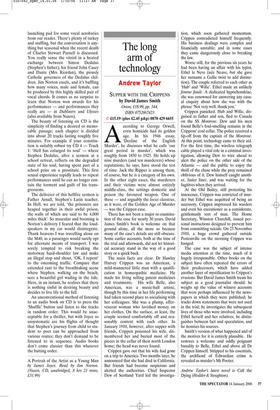The long arm of
technology
Andrew Taylor
SUPPER WITH THE CRIPPENS by David James Smith Orion, £18.99, pp. 344, ISBN 0752867423 ✆ £15.19 (plus £2.45 p&p) 0870 429 6655 According to George Orwell, even homicide had its golden age. In his 1946 essay, ‘Decline of the English Murder’, he discusses what he calls ‘our great period in murder’, which was roughly from 1850 to 1925. He holds up nine murders (and ten murderers) whose reputations, he says, have stood the test of time. Jack the Ripper is among them, of course, but he is a category of his own. In the other eight cases, the murderers and their victims were almost entirely middle-class, the settings domestic and poison the favoured weapon. One of these — and arguably the locus classicus, as it were, of the Golden Age of Murder — was the Crippen case.
There has not been a major re-examination of the case for nearly 30 years. David James Smith’s book is welcome on that ground alone, all the more so because many of the case’s details are still obscure. Some earlier accounts, both at the time of the trial and afterwards, did not let historical accuracy stand in the way of a good story or a quick buck.
The main facts are clear. Dr Hawley Harvey Crippen was an American, a mild-mannered little man with a qualification in homeopathic medicine. He made his living selling patent medicines and treatments. His wife Belle, also American, was a music-hall artiste, though by this time in her life performing had taken second place to socialising with her colleagues. She was a plump, effervescent woman who lavished money on her clothes. On the surface, at least, the couple seemed comfortably off and reasonably content with each other. In January 1910, however, after supper with friends, Crippen poisoned his wife, dismembered her and buried most of the pieces in the cellar of their north London home; the head was never found.
Crippen gave out that his wife had gone on a trip to America. Two months later, he announced that she had died in California. But friends had become suspicious and alerted the authorities. Chief Inspector Dew of Scotland Yard led the investiga tion, which soon gathered momentum. Crippen contradicted himself frequently. His business dealings were complex and financially unstable; and in some cases they came dangerously close to breaking the law.
Worse still, for the previous six years he had been having an affair with his typist, Ethel le Neve (née Neave, but she gave her surname a Gallic twist to add distinction). The couple referred to each other as ‘Hub’ and ‘Wifie’. Ethel made an unlikely femme fatale. A dedicated hypochondriac, she was renowned for answering any casual enquiry about how she was with the phrase ‘Not very well, thank you.’ Crippen panicked. Hub and Wifie, disguised as father and son, fled to Canada on the SS Montrose. Dew and his men found Belle’s foul-smelling remains in the Crippens’ coal cellar. The police received a tip-off from the captain of the Montrose. At this point, technology came to their aid. For the first time, the wireless telegraph cable played a vital role in a criminal investigation, allowing Dew to wire ahead to alert the police on the other side of the Atlantic — and the public to enjoy the thrill of the chase while the prey remained oblivious of it. Dew himself caught another, faster liner, and was waiting for the fugitives when they arrived.
At the Old Bailey, still protesting his innocence, Crippen was convicted of murder but Ethel was acquitted of being an accessory. Crippen impressed his warders and even his executioner as a considerate, gentlemanly sort of man. The Home Secretary, Winston Churchill, issued personal instructions designed to prevent him from committing suicide. On 23 November 1910, a huge crowd gathered outside Pentonville on the morning Crippen was hanged.
The case was the subject of intense media attention at the time, much of it hugely irresponsible. Other books on the subject have often repeated the errors of their predecessors, which have added another layer of mystification to Crippen’s evasions. But David James Smith treats his subject as a good journalist should: he weighs up the value of witness accounts that were perhaps influenced by the newspapers in which they were published; he tracks down statements that were not used in the trial; he investigates the subsequent lives of those who were involved, including Ethel herself and her relatives; he distinguishes between fact and speculation, and he itemises his sources.
Smith’s version of what happened and of the motives for it is entirely plausible. He restores a welcome and oddly poignant banality to Belle, Ethel and above all Dr Crippen himself. Stripped to his essentials, the archfiend of Edwardian crime is revealed as murder’s Mr Pooter.














































 Previous page
Previous page